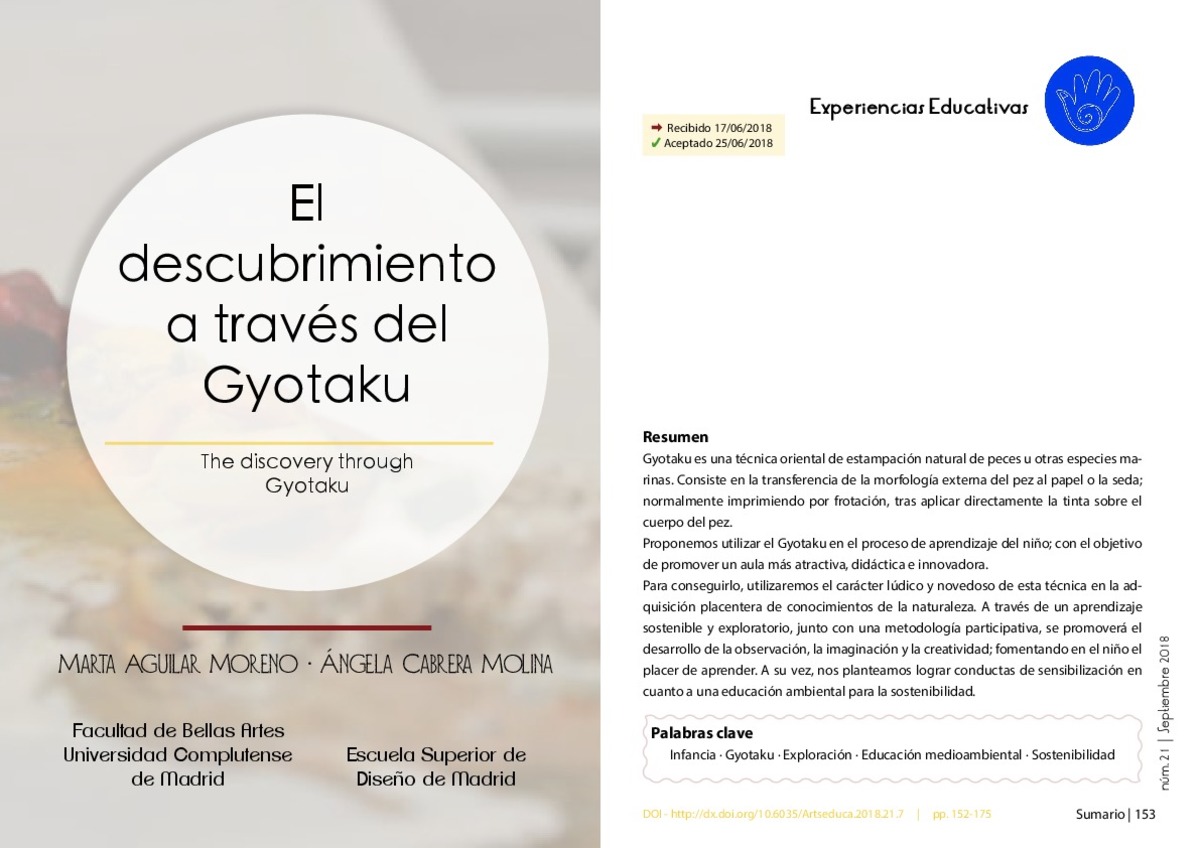Mostrar el registro sencillo del ítem
El descubrimiento a través del Gyotaku
| dc.contributor.author | Aguilar Moreno, Marta | |
| dc.contributor.author | Cabrera Molina, Ángela | |
| dc.date.accessioned | 2019-07-17T10:49:55Z | |
| dc.date.available | 2019-07-17T10:49:55Z | |
| dc.date.issued | 2018-09 | |
| dc.identifier.citation | AGUILAR MORENO, Marta; CABRERA MOLINA, Ángela. El descubrimiento a través del Gyotaku. Artseduca, 2018, no 21, p. 152-175. | ca_CA |
| dc.identifier.issn | 2254-0709 | |
| dc.identifier.uri | http://hdl.handle.net/10234/183284 | |
| dc.description.abstract | Gyotaku es una técnica oriental de estampación natural de peces u otras especies marinas. Consiste en la transferencia de la morfología externa del pez al papel o la seda; normalmente imprimiendo por frotación, tras aplicar directamente la tinta sobre el cuerpo del pez. Proponemos utilizar el Gyotaku en el proceso de aprendizaje del niño; con el objetivo de promover un aula más atractiva, didáctica e innovadora. Para conseguirlo, utilizaremos el carácter lúdico y novedoso de esta técnica en la adquisición placentera de conocimientos de la naturaleza. A través de un aprendizaje sostenible y exploratorio, junto con una metodología participativa, se promoverá el desarrollo de la observación, la imaginación y la creatividad; fomentando en el niño el placer de aprender. A su vez, nos planteamos lograr conductas de sensibilización en cuanto a una educación ambiental para la sostenibilidad. | ca_CA |
| dc.description.abstract | Gyotaku is an oriental technique of natural stamping of fsh or other marine species. It consists of the transfer of the external morphology of the fsh to paper or silk; normally printing by rubbing, after applying the ink on the body of the fsh directly. We propose to use Gyotaku in the child’s learning process; with the aim of promoting a more attractive, didactic and innovative classroom. To achieve this, we will use the playful and innovative nature of this technique in the pleasant acquisition of knowledge of nature. Through a sustainable and exploratory learning, together with a participatory methodology, the development of observation, imagination and creativity will be promoted; fostering in the child the pleasure of learning. At the same time, we set out to achieve awareness-raising behaviors regarding environmental education for sustainability. | ca_CA |
| dc.format.extent | 12 p. | ca_CA |
| dc.format.mimetype | application/pdf | ca_CA |
| dc.language.iso | spa | ca_CA |
| dc.publisher | Ana M. Vernia Carrasco | ca_CA |
| dc.relation.isPartOf | Artseduca, 2018, no. 21 | ca_CA |
| dc.rights.uri | http://creativecommons.org/licenses/by-sa/4.0/ | |
| dc.subject | infancia | ca_CA |
| dc.subject | Gyotaku | ca_CA |
| dc.subject | exploración | ca_CA |
| dc.subject | educación medioambiental | ca_CA |
| dc.subject | sostenibilidad | ca_CA |
| dc.subject | childhood | ca_CA |
| dc.subject | exploration | ca_CA |
| dc.subject | environmental education | ca_CA |
| dc.subject | sustainability | ca_CA |
| dc.title | El descubrimiento a través del Gyotaku | ca_CA |
| dc.title.alternative | The discovery through Gyotaku | ca_CA |
| dc.type | info:eu-repo/semantics/article | ca_CA |
| dc.identifier.doi | http://dx.doi.org/10.6035/Artseduca.2018.21.7 | |
| dc.rights.accessRights | info:eu-repo/semantics/openAccess | ca_CA |
Ficheros en el ítem
Este ítem aparece en la(s) siguiente(s) colección(ones)
-
Artseduca_2018_no.21 [10]








